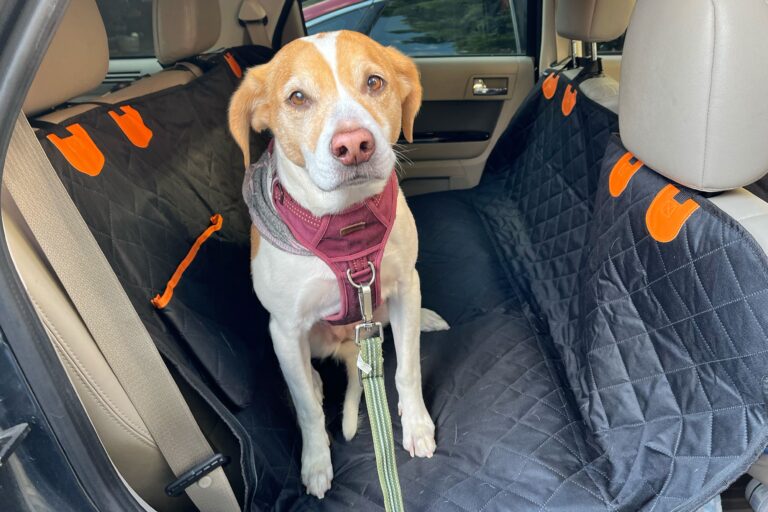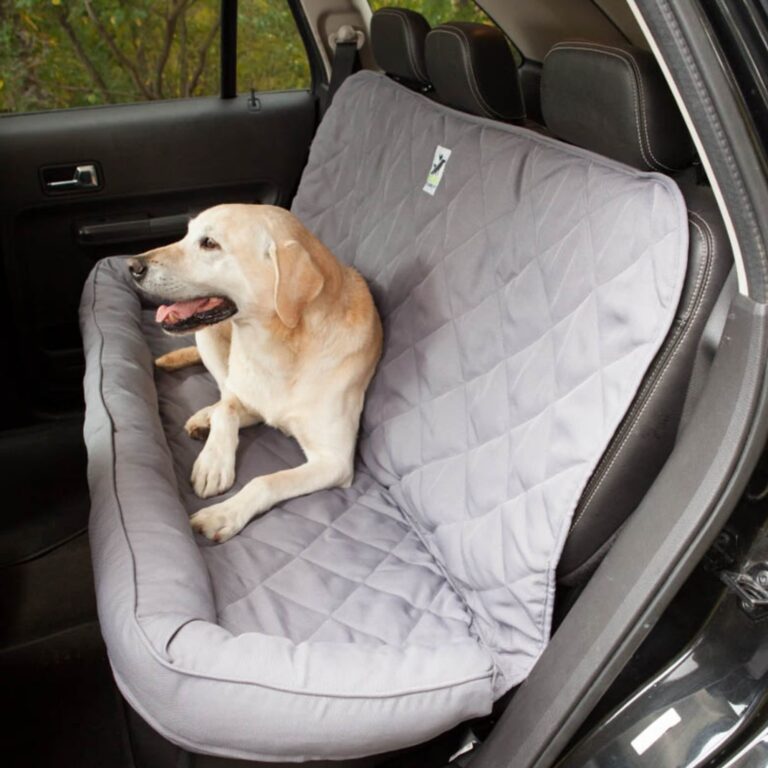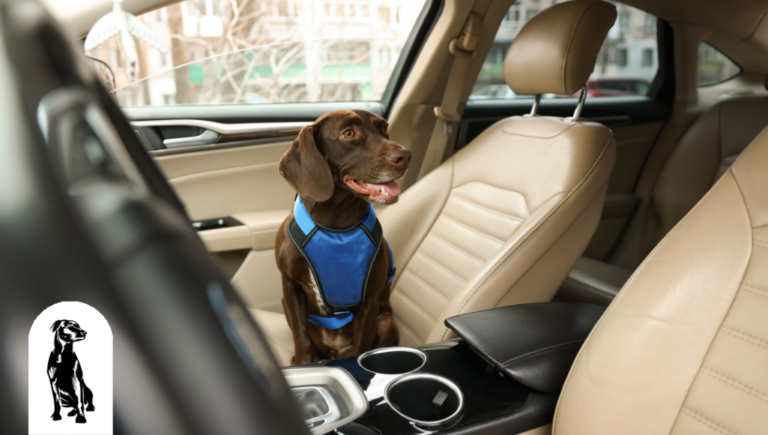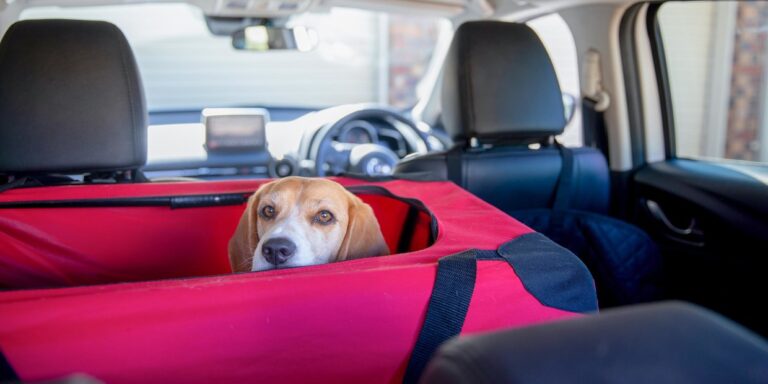How Long Can a Dog Be in a Car Trip? Essential Tips for Pet Safety
A dog can be in a car trip for about two to three hours. Frequent breaks are necessary for their comfort and health.
Traveling with a dog requires careful planning to ensure their well-being. Dogs need regular breaks to stretch, hydrate, and relieve themselves. Long car trips can be stressful for pets, so frequent stops every two to three hours are essential. Make sure your dog has access to water and a comfortable space in the car.
Bringing familiar items like their favorite blanket or toy can help reduce anxiety. Always monitor the temperature inside the car to prevent overheating. Proper preparation can make the journey enjoyable and safe for both you and your furry friend.
Assessing Your Dog’s Readiness For Road Trips
Before embarking on a long car trip with your dog, assess their readiness. This includes evaluating their health, temperament, and doing trial runs. Ensuring your dog is comfortable and safe makes the trip enjoyable for both of you.
Evaluating Health And Temperament
Your dog’s health and temperament play a crucial role in determining if they are ready for a road trip. Consider the following points:
- Health Check: Ensure your dog is healthy. Visit the vet for a check-up.
- Temperament: Is your dog anxious or calm? Their behavior matters.
- Age and Physical Condition: Puppies and senior dogs may have different needs.
Use this simple table to track your dog’s readiness:
| Factor | Readiness |
|---|---|
| Health | Vet approval |
| Temperament | Calm and relaxed |
| Age | Suitable for travel |
Trial Runs: Short Drives Before The Big Journey
Conducting trial runs is essential before a long trip. Short drives help your dog get used to the car.
- Start with very short drives, around the block or to a nearby park.
- Gradually increase the length of these trips as your dog gets comfortable.
- Observe your dog’s behavior. Are they calm or restless?
- Bring along toys and treats to make the experience positive.
- Ensure your dog has a comfortable space in the car.
Trial runs prepare your dog for longer trips. They help you understand your dog’s needs. This step is crucial for a successful road trip.
Pre-trip Preparations For Canine Comfort
Planning a road trip with your dog? Ensure frequent breaks every 2-3 hours to keep your furry friend comfortable and safe. Proper hydration and ventilation are essential for a smooth journey.
Taking your dog on a car trip can be exciting. Proper preparation ensures your furry friend’s comfort and safety. Here are some tips to make the journey smooth and enjoyable.Packing Essentials For Your Pooch
Packing for your dog is just as important as packing for yourself. Make sure to include all necessary items to keep your pet comfortable and happy.- Food and Water: Bring enough food and water for the entire trip. Don’t forget the bowls!
- Favorite Toys: Pack some toys to keep your dog entertained during the ride.
- Blankets and Bedding: Bring familiar bedding to help your dog feel at home.
- Cleaning Supplies: Pack waste bags, wipes, and paper towels for any accidents.
- Health Records: Carry your dog’s health records in case of emergencies.
Safety Gear: Harnesses And Carriers
Safety is a top priority on a car trip. Proper gear can protect your dog during the journey.| Item | Description |
|---|---|
| Harness | A harness keeps your dog secure and prevents distractions while driving. |
| Carrier | A carrier is ideal for smaller dogs. It provides a safe and comfortable space. |
| Seat Belt | A dog seat belt attaches to a harness, adding an extra layer of safety. |
Calculating Safe Duration For Dog Travel
Understanding how long your dog can stay in a car trip is crucial. Dogs have different needs and tolerances. Calculating the safe duration helps ensure their comfort and safety.
Factors Affecting Travel Time
Several factors influence how long a dog can stay in a car. These include the dog’s age, breed, health, and temperament.
- Age: Puppies and senior dogs need more breaks. They have less bladder control.
- Breed: Some breeds tolerate travel better. Brachycephalic breeds may struggle with breathing.
- Health: Dogs with health issues need frequent stops. This keeps them comfortable.
- Temperament: Anxious dogs may stress easily. Calm dogs handle longer trips.
Signs Of Stress And Discomfort
Recognizing signs of stress ensures your dog stays safe. Look for these signs during travel:
- Panting: Excessive panting can indicate stress or overheating.
- Whining: Continuous whining shows discomfort or anxiety.
- Restlessness: Pacing or fidgeting signals the need for a break.
- Drooling: Excessive drooling may indicate nausea or stress.
- Vomiting: This is a clear sign of motion sickness or extreme stress.
Use the information to keep your dog safe and happy during car trips. Plan your trip with frequent breaks. Ensure your dog has water and a comfortable space.
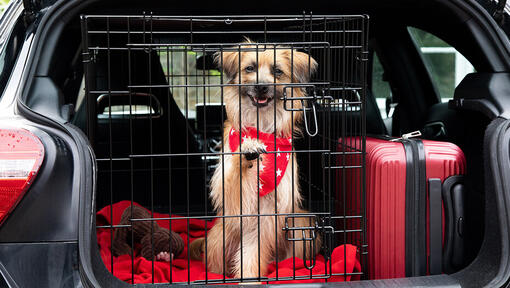
Credit: www.purina.co.uk
Scheduling Breaks And Activities
Planning a car trip with your dog requires careful consideration of breaks and activities. Regular stops keep your dog comfortable and happy. It also ensures the journey is enjoyable for both of you.
Importance Of Regular Stops
Regular stops are essential during long car trips. Dogs need to stretch their legs and relieve themselves. Aim for a break every two to three hours.
Short breaks prevent your dog from becoming restless or anxious. They also reduce the risk of health issues like urinary infections.
During these stops, offer your dog water and a chance to sniff around. This helps them stay hydrated and mentally stimulated.
Exercise And Play During Halts
Exercise and play are crucial during halts. Engaging activities tire your dog out and make the trip smoother.
Bring along toys and a ball for fetch. Interactive games keep your dog entertained and happy.
Walking your dog on a leash during breaks is also important. This not only provides physical exercise but also mental stimulation.
Choose safe, open areas for play. Avoid busy roads or places with too many distractions.
| Time | Activity |
|---|---|
| Every 2-3 hours | Stop for a break |
| During breaks | Offer water and a walk |
| During breaks | Engage in play or fetch |
- Ensure your dog is always on a leash during stops.
- Carry a portable water bowl for hydration.
- Pack your dog’s favorite toys for playtime.
Feeding And Hydration On The Road
Keeping your dog well-fed and hydrated is crucial during a car trip. Proper planning ensures your dog stays happy and healthy. This section covers essential tips for meal planning and ensuring access to fresh water.
Meal Planning For Travel
Plan your dog’s meals carefully before the trip. Dogs need to stick to their routine diet. Bring enough dog food to last the entire trip.
Pack meals in airtight containers. This keeps the food fresh and prevents spills. Use portion-sized containers for easy feeding.
- Feed your dog at their regular times.
- Avoid feeding your dog right before the trip.
- Give them a light meal to prevent car sickness.
Ensuring Access To Fresh Water
Fresh water is vital during a car trip. Dogs can get dehydrated quickly. Bring a portable water bowl and bottles of fresh water.
Offer water to your dog every 2-3 hours. This keeps them hydrated and comfortable.
Consider using a spill-proof water bowl. This prevents messes and ensures your dog can drink easily.
| Item | Purpose |
|---|---|
| Portable Water Bowl | Easy access to water |
| Water Bottles | Ensure fresh water supply |
| Spill-proof Bowl | Prevent water spills |
Always check the water temperature. Dogs prefer cool, fresh water. Avoid giving them warm or hot water.
Temperature Control And Ventilation
Ensuring your dog’s comfort during a car trip is essential. Temperature control and ventilation play a crucial role in keeping your pet safe. Dogs can easily overheat, making proper air circulation and temperature regulation vital.
Managing Car Temperature
To manage car temperature effectively, use the air conditioning. Keep the car cool but not too cold. A comfortable temperature for dogs is between 68-72°F (20-22°C). Monitor the temperature using a car thermometer.
Avoid leaving your dog in a parked car. Even with the windows cracked, temperatures can rise quickly. On a hot day, the inside of a car can reach 120°F (49°C) in minutes. This can be lethal for dogs.
| Outside Temperature | Time in Car | Inside Car Temperature |
|---|---|---|
| 75°F (24°C) | 10 minutes | 94°F (34°C) |
| 85°F (29°C) | 10 minutes | 104°F (40°C) |
| 95°F (35°C) | 10 minutes | 114°F (46°C) |
Adequate Airflow For Your Pet
Adequate airflow is just as important as temperature control. Ensure your car’s ventilation system works properly. Use vents to direct cool air towards your dog. This helps maintain a steady airflow.
Consider using a pet travel crate with good ventilation. Crates with mesh sides allow air to circulate freely. For extra airflow, use a portable fan designed for pets. These fans can clip onto the crate and provide a gentle breeze.
Take frequent breaks during long trips. Let your dog out for fresh air and a short walk. This helps reduce the risk of overheating and ensures your pet stays comfortable.
- Monitor the car temperature regularly
- Never leave your dog in a parked car
- Ensure proper ventilation with car vents and portable fans
- Use a well-ventilated pet travel crate
- Take frequent breaks for fresh air and exercise
By managing temperature and ensuring adequate airflow, you can make car trips safe and comfortable for your dog.
Dealing With Motion Sickness And Anxiety
Traveling with your dog can be a joyful experience. Yet, dealing with motion sickness and anxiety can make trips stressful for your furry friend. Understanding and addressing these issues can ensure a smooth journey.
Identifying And Easing Symptoms
Recognizing the signs of motion sickness and anxiety is crucial. Look for symptoms like:
- Excessive drooling
- Panting
- Whining
- Vomiting
- Restlessness
These symptoms indicate discomfort. Stopping the car frequently allows your dog to stretch and relax. Keeping the car cool also helps soothe your dog. Short practice trips can help your dog get used to traveling. Gradually increase the duration to build their tolerance.
Remedies And Comfort Measures
There are several ways to make your dog comfortable during a car trip:
- Use a Crate or Carrier: It provides a safe, confined space.
- Comfort Items: Bring familiar items like their favorite blanket or toy.
- Avoid Feeding: Don’t feed your dog right before the trip to prevent nausea.
- Medication: Consult your vet about anti-nausea medication or calming supplements.
- Calming Music: Play soft music to reduce anxiety.
Maintaining a calm demeanor is essential. Your dog senses your emotions. Stay relaxed to help them feel secure. Hydration is key. Offer water during breaks to keep your dog hydrated.
The table below lists some helpful remedies:
| Remedy | Benefit |
|---|---|
| Crate or Carrier | Provides safety and security |
| Comfort Items | Reduces anxiety with familiar scents |
| Anti-nausea Medication | Prevents motion sickness |
| Soft Music | Calms your dog |
Following these tips can make your car trips enjoyable and stress-free for your dog.
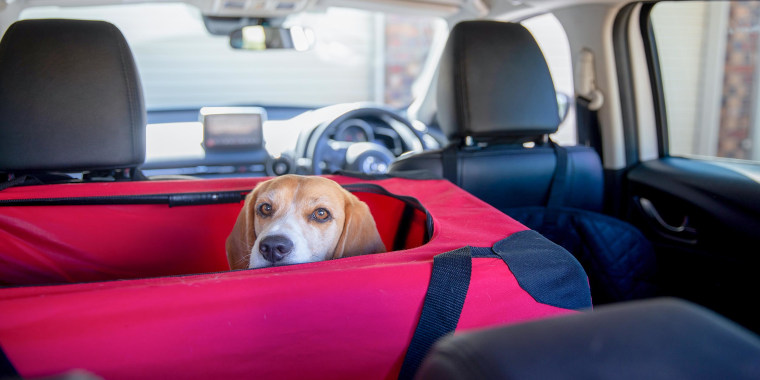
Credit: www.nbcnews.com
Emergency Preparedness And First Aid
Ensuring your dog’s safety during a car trip is crucial. Emergency preparedness and first aid are essential for a smooth journey. This section will guide you on creating a canine first aid kit and knowing the nearest vet locations.
Creating A Canine First Aid Kit
A well-prepared first aid kit can save your dog’s life. Here’s what you need:
- Bandages – For minor cuts and injuries.
- Gauze pads – To cover wounds.
- Antiseptic wipes – To clean wounds.
- Tweezers – To remove splinters or ticks.
- Hydrogen peroxide – To induce vomiting if ingested something harmful.
- Thermometer – To check your dog’s temperature.
- Eye dropper – For administering liquids.
- Emergency blanket – To keep your dog warm.
- Scissors – For cutting bandages.
- Flashlight – To check your dog in low light.
Knowing The Nearest Vet Locations
Locate the nearest vet before your trip. This ensures quick help in emergencies. Here’s how:
- Search online for vets along your route.
- Save their contact info on your phone.
- Print a list of addresses and phone numbers.
- Use GPS to find the quickest route to the vet.
Having this information at hand can make a big difference. It helps you act quickly during emergencies.
Legal Requirements And Documentation
Traveling with your dog can be a joyous experience. However, understanding the legal requirements and carrying the necessary documentation is crucial. This ensures a smooth journey and avoids any potential legal issues. Below, we delve into the essential aspects you need to consider.
Understanding State Laws And Regulations
Each state has its own set of laws and regulations regarding pets in vehicles. It’s important to be aware of these to avoid fines or legal complications. Here are some key points:
- Restraint Laws: Some states require pets to be restrained while in a vehicle. This means using a pet seatbelt or a crate.
- Temperature Regulations: Many states have laws against leaving pets in hot or cold cars. This is to prevent heatstroke or hypothermia.
- Travel Time Limits: Certain states may have guidelines on how long a pet can be in a car without a break.
Make sure to research the specific laws of each state you will be traveling through.
Carrying The Necessary Paperwork
Having the right documentation is essential for a hassle-free trip. Here are some documents you should carry:
- Vaccination Records: Ensure your dog’s vaccination records are up to date and keep a copy with you.
- Health Certificate: Some states require a health certificate from your vet, especially if you are crossing state lines.
- Identification Tags: Your dog should have an ID tag with your contact information. A microchip can also be helpful.
Keep these documents in an easily accessible place, such as a glove compartment or a travel bag.
| Document | Why It’s Needed |
|---|---|
| Vaccination Records | Proof of vaccinations to prevent disease spread. |
| Health Certificate | Certifies your dog is healthy for travel. |
| Identification Tags | Helps in identifying your dog if lost. |

Credit: news.orvis.com
Post-trip Care: Ensuring Your Dog’s Well-being
After a long car trip, your dog’s well-being is crucial. Proper post-trip care ensures your furry friend stays healthy and happy. Follow these steps to provide the best care for your dog after a journey.
Post-travel Health Check
Once you reach your destination, conduct a thorough health check for your dog. Look for any signs of stress or discomfort. Pay attention to their breathing and movement. Check their paws, eyes, ears, and coat for any abnormalities.
A quick health check includes:
- Inspecting paws for cuts or abrasions.
- Checking ears for signs of infection.
- Examining eyes for redness or discharge.
- Feeling their coat for any ticks or fleas.
If you notice anything unusual, consult a vet immediately. A professional can provide the best advice and treatment for your pet.
Recovery Time After A Long Car Trip
After a long car trip, dogs need ample recovery time. Rest and relaxation are essential. Ensure your dog has access to fresh water and a comfortable resting spot.
A recovery schedule might include:
- Allowing your dog to rest in a quiet area.
- Providing a balanced meal after they have settled.
- Gradually reintroducing physical activities.
Observe your dog’s behavior over the next few days. Look for signs of fatigue or stress. If your dog seems lethargic or shows signs of anxiety, give them more time to rest.
Remember, each dog is unique. Their recovery time may vary. Be patient and provide the support your dog needs for a swift recovery.
Frequently Asked Questions
How To Drive 8 Hours With A Dog?
Take frequent breaks. Ensure your dog is comfortable. Bring water, food, and toys. Use a secure crate or harness.
Is It Ok To Leave Dog In Car For 15 Minutes?
Leaving a dog in a car, even for 15 minutes, can be dangerous. Cars heat up quickly, causing heatstroke.
Can Long Car Rides Affect Dogs?
Yes, long car rides can affect dogs. They might experience stress, anxiety, or motion sickness. Ensure frequent breaks for exercise and bathroom needs. Bring water and their favorite toys to keep them comfortable.
How Many Hours Can A Dog Travel?
Dogs can travel for 4-6 hours with regular breaks. Ensure they have water and a comfortable space.
Conclusion
Ensuring your dog’s comfort during car trips is crucial. Plan regular stops for exercise and hydration. Avoid leaving them alone in the car. Prioritize their well-being to make the journey enjoyable for everyone. With these tips, your furry friend will travel safely and happily on your next adventure.
- Can I Get in a Taxi Without a Car Seat? - January 26, 2025
- Can I Get Chlamydia From a Toilet Seat? - January 26, 2025
- Can I Get an Uber With a Car Seat? - January 26, 2025

